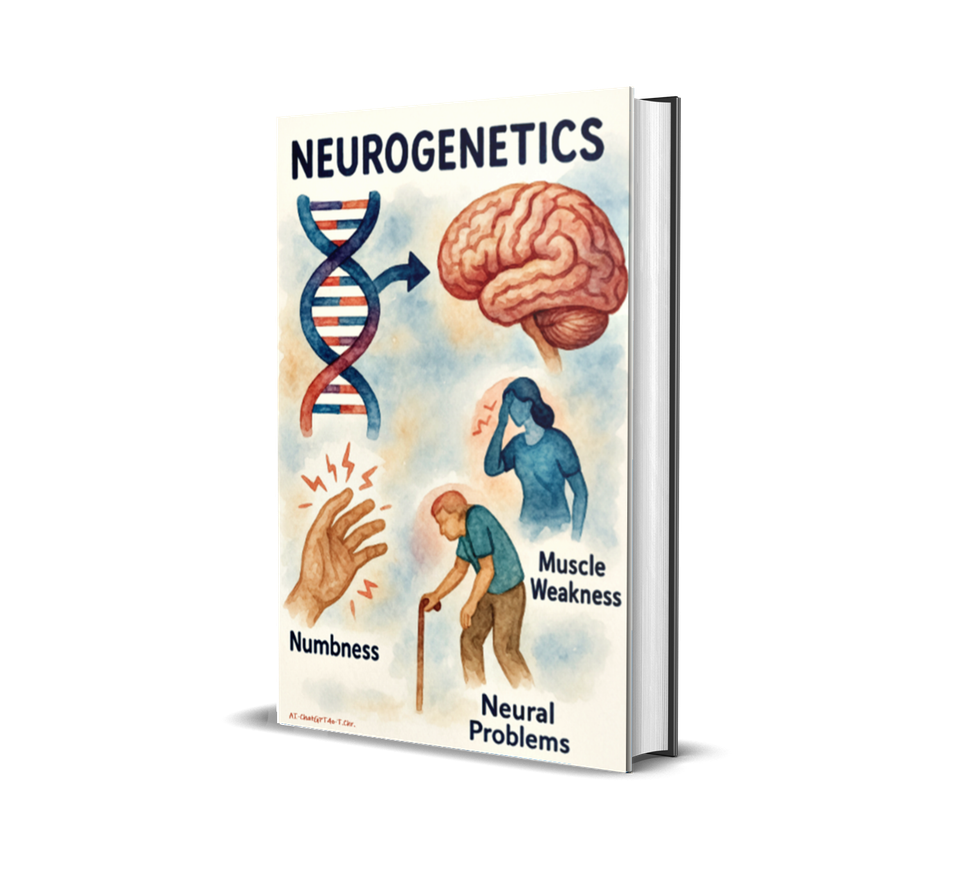A Journey Through the History of Neurogenetics

By AI-ChatGPT4o-T.Chr.-Human Synthesis-18 July 2025
Abstract. Since the late 19th century, when several inherited neurological disorders were described, the close relationship between neurology and heredity was well documented by various authors in the pre-genetic era. The term "Neurogenetics" emerged to integrate two vast sciences and clinical practices: Neurology and Genetics.
Neurogenetics is an emerging field that studies the correlation between the genetic code and the development and function of the nervous system, including behavioral traits, personality, and neurological diseases. This historical note presents a timeline of key events and contributors from the earliest reports of neurogenetic diseases to the present day.
In recent years, neurologists have seen a broader use of genetic diagnostic techniques in clinical practice. Consequently, new challenges have arisen in diagnostic approaches, ethical considerations, and therapeutic options. This article aims to summarize the major historical hallmarks of neurogenetics, from the pre-DNA era to the present, and outlines future directions for the field.
Keywords: Genetic Diseases, Inborn; History; Neurology; Genetics
THE FIRST NEUROGENETIC DISEASES
With the birth of modern neurology in the late 19th century, many physicians noted the importance of family history in diagnosing neurological disorders. Concurrently, early genetics research sought to understand the mechanisms behind inherited diseases.
The term Neurogenetics formally began in the mid-1960s, when Seymour Benzer conducted experiments with Drosophila (fruit flies) to demonstrate that single gene mutations could influence behavior. His work laid the foundation for the study of neurological diseases in humans, particularly neurodegenerative disorders.
Gregor Mendel, known as the "father of modern genetics," published his work on pea plant hybridization in 1866, outlining the laws of inheritance. Though his work was initially overlooked, it was rediscovered in 1900. However, even before Mendel, physicians recognized inherited patterns in neurological diseases.
- In 1863, Nikolaus Friedreich described a hereditary juvenile-onset ataxia involving sensory loss, cardiomyopathy, scoliosis, and pes cavus. Over a century later, Friedreich's ataxia was linked to a GAA trinucleotide repeat.
- In 1872, George Huntington wrote "On Chorea," describing the hereditary nature, psychiatric symptoms, and adult onset of Huntington’s disease, now known to be caused by a CAG trinucleotide repeat.
- In 1880, hereditary spastic paraplegia was described by Ernst von Strümpell, with later anatomical contributions by Maurice Lorrain.
- In 1886, Charcot and Marie in France, and Henry Tooth in England, independently described hereditary sensorimotor neuropathy (Charcot-Marie-Tooth disease).
- In 1893, Pierre Marie described adult-onset ataxia with oculomotor abnormalities and autosomal dominant inheritance, later grouped under spinocerebellar ataxias (SCA).
DNA DISCOVERY AND MOVING ON
In the 1910s, Thomas Morgan proved that genes reside at specific chromosome locations. In 1944, Avery, MacLeod, and McCarty demonstrated that DNA carries genetic information. Watson and Crick revealed DNA’s double-helix structure in 1953.
In the late 1950s, Benzer introduced the concept of "point mutations." Fredrick Sanger's development of a widely used DNA sequencing method in the 1970s revolutionized genetic research.
By the 1980s, molecular biology enabled disease-gene association through linkage analysis. This led to the identification of Huntington’s disease locus in 1983 and the Duchenne muscular dystrophy gene in 1987.
The 1990s saw the discovery of microsatellites and easier genotyping via PCR. This led to gene discoveries for Charcot-Marie-Tooth, ALS, Parkinson’s, Alzheimer’s, spinocerebellar ataxias, and fragile X syndrome.
Anita Harding notably contributed to understanding mitochondrial DNA mutations and the concept of tissue heteroplasmy.
In the 2000s, combining phenotypic mapping, sequencing, and computational tools allowed for the identification of many hereditary disorders. The Human Genome Project (1990–2003) sequenced the full human genome. Next-generation sequencing (NGS), developed by 2010, enabled rapid genome analysis. In Brazil, institutions like the Human Genome and Stem Cell Research Center at USP have played key roles in neurogenetics.
THE ERA OF EXOME SEQUENCING
NGS revolutionized genetic investigation. Whole Exome Sequencing (WES) enabled efficient identification of monogenic diseases by focusing on coding regions of the genome. WES and Whole Genome Sequencing (WGS) now detect single nucleotide variants and small insertions/deletions (InDels). Larger InDels and structural variants are best assessed using microarrays and MLPA.
FUTURE DIRECTIONS: WHAT IS NEXT?
With NGS, diagnostic approaches are shifting. For instance, WES is proving to be a superior diagnostic method for leukodystrophies, offering precision, speed, and cost-efficiency compared to traditional biochemical methods.
As technology advances, continuous updating in data interpretation and genetic counseling becomes essential. Ethical issues emerge, including:
- Genetic testing in asymptomatic individuals
- Psychological effects of diagnosis (e.g., Huntington's disease)
- Confidentiality
- Testing in children
- Prenatal and embryo testing
Treatment is also evolving. While once limited to symptomatic care, disease-modifying drugs are now being approved:
- Miglustat (Niemann-Pick type C)
- Migalastat (Fabry disease)
- Antisense oligonucleotides (ASO) for Duchenne muscular dystrophy
- Gene therapy trials for Huntington's and SCA2
- CRISPR-Cas9 genome editing as a future therapeutic tool
Neurogenetics continues to advance rapidly, transforming diagnosis, ethical thinking, and treatment in neurology.
Editor comments.
Many people are suffering from the effects of Covid-19 and Long-Covid. Are you taking sleeping medicine as well, the same side effects will double. Neurogenetics is helping to resolve these problems.
